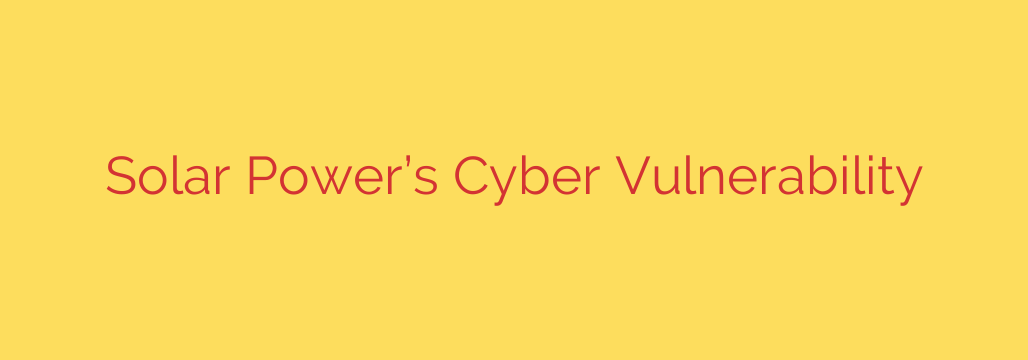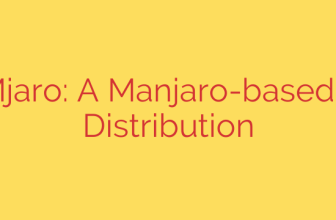
Securing the Sunshine: The Growing Cybersecurity Threat to Solar Energy
Solar energy is a cornerstone of our clean energy future, with panels appearing on everything from residential rooftops to vast, utility-scale farms. This rapid growth is powered by smart technology that makes solar power more efficient and accessible than ever. But as millions of these systems connect to the internet and our power grid, a critical, often-overlooked vulnerability is emerging: cybersecurity.
The very connectivity that makes solar systems “smart” also makes them a potential target for malicious actors. Understanding these risks is the first step toward building a truly resilient and secure green energy infrastructure.
Why Solar Infrastructure is a Prime Target
Modern solar energy systems are far more than simple panels that capture sunlight. They are complex networks of interconnected devices, often referred to as the Internet of Things (IoT). At the heart of this network are inverters, monitoring software, and control systems that communicate with each other and often, over the public internet.
This digital foundation creates multiple entry points for cyberattacks. Hackers are no longer just targeting computers and corporate servers; they are increasingly setting their sights on critical infrastructure, and our power grid is one of the most vital targets. As solar energy becomes a more significant part of that grid, its security becomes paramount.
The Core Vulnerabilities in Solar Systems
The threat isn’t hypothetical. Security researchers have repeatedly demonstrated how easy it can be to compromise solar energy components. The vulnerabilities typically fall into a few key categories:
- Solar Inverters: The inverter is the brain of any solar installation. It converts the direct current (DC) electricity generated by the panels into alternating current (AC) that can be used by homes and fed into the grid. Most inverters are now connected to the internet for remote monitoring and maintenance. If a hacker gains control of an inverter, or a large number of them, they could suddenly shut them down, manipulate energy output, or even attempt to damage the hardware itself.
- Unsecured Communications: Many solar components communicate using standard internet protocols, but not always with the necessary security layers. Weak or non-existent encryption can allow attackers to intercept or alter data flowing between the solar array and its monitoring platform. This could be used to mask a physical attack or falsify energy production reports.
- Weak Credentials and Default Passwords: A shocking number of IoT devices, including some solar equipment, are installed with factory-set default usernames and passwords. These credentials are often publicly known and provide an easy backdoor for anyone scanning the internet for vulnerable systems.
- Outdated Software and Firmware: Like any smart device, solar inverters and controllers run on software. Failure to apply regular security patches and firmware updates leaves known vulnerabilities exposed, giving attackers a clear and predictable path to exploit the system.
What’s at Stake: The Real-World Impact
A successful cyberattack on solar infrastructure could have devastating consequences, ranging from individual financial loss to widespread power disruption.
- Grid Instability: The most significant threat involves a large-scale, coordinated attack. If a bad actor could simultaneously control thousands of distributed solar inverters, they could switch them on or off in unison. This could create a massive fluctuation in power supply, potentially destabilizing the electrical grid and causing regional blackouts.
- Denial of Service: An attacker could simply shut down a commercial or utility-scale solar farm, stopping it from generating power and causing significant financial losses for its owners.
- Data Theft: Compromised monitoring systems can reveal sensitive information about a home or business’s energy consumption patterns, which could be used to determine when occupants are away.
- Ransomware: Attackers could lock operators out of their own solar farm control systems and demand a ransom to restore access, a tactic already common in other industrial sectors.
Actionable Steps to Secure Your Solar Power System
Protecting our solar infrastructure requires a proactive approach from manufacturers, installers, and owners alike. Whether you manage a large solar farm or have panels on your roof, these security best practices are essential.
- Change All Default Credentials Immediately. This is the single most important step. Before your system is even fully operational, ensure that every component has a unique, strong password. Avoid using easily guessable information.
- Keep Firmware and Software Consistently Updated. Treat your solar inverter like your computer or smartphone. Regularly check for and install security updates provided by the manufacturer. These patches are specifically designed to close newly discovered security holes.
- Secure Your Network. Isolate your solar energy components on a separate, firewalled network whenever possible. This practice, known as network segmentation, prevents an attacker who breaches your main Wi-Fi from easily accessing your energy systems.
- Vet Your Manufacturer and Installer. When choosing solar equipment, ask about the manufacturer’s security practices. Reputable companies will have a clear policy on security patching and responsible disclosure of vulnerabilities. Ensure your installer is knowledgeable about cybersecurity best practices.
- Enable Secure Communication Protocols. If your system offers options like HTTPS or other encrypted communication channels for monitoring, ensure they are enabled. This protects your data as it travels over the internet.
Ultimately, the transition to renewable energy is essential, but it cannot be done at the expense of security. By recognizing that solar power is a form of critical digital infrastructure and taking deliberate steps to protect it, we can ensure that our clean energy future is also a safe and resilient one.
Source: https://www.helpnetsecurity.com/2025/10/14/solar-power-systems-cyber-threats/








